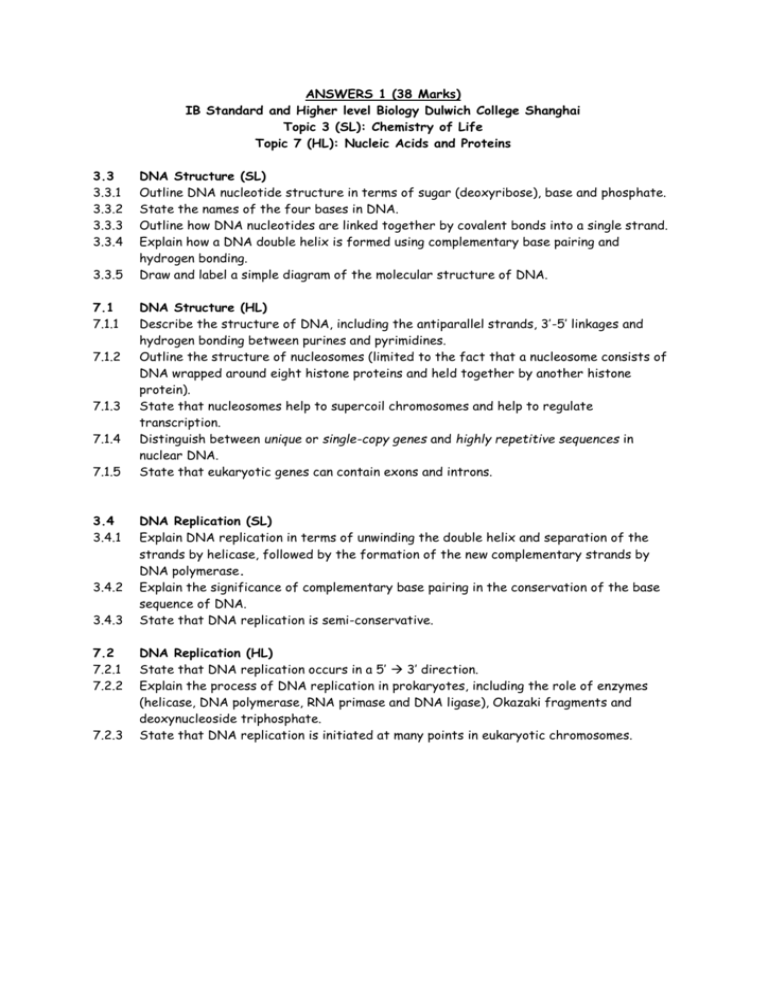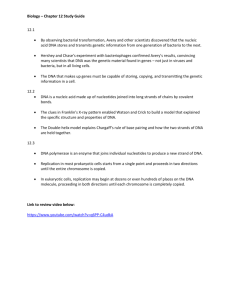File
advertisement

ANSWERS 1 (38 Marks) IB Standard and Higher level Biology Dulwich College Shanghai Topic 3 (SL): Chemistry of Life Topic 7 (HL): Nucleic Acids and Proteins 3.3 3.3.1 3.3.2 3.3.3 3.3.4 3.3.5 7.1 7.1.1 7.1.2 7.1.3 7.1.4 7.1.5 3.4 3.4.1 3.4.2 3.4.3 7.2 7.2.1 7.2.2 7.2.3 DNA Structure (SL) Outline DNA nucleotide structure in terms of sugar (deoxyribose), base and phosphate. State the names of the four bases in DNA. Outline how DNA nucleotides are linked together by covalent bonds into a single strand. Explain how a DNA double helix is formed using complementary base pairing and hydrogen bonding. Draw and label a simple diagram of the molecular structure of DNA. DNA Structure (HL) Describe the structure of DNA, including the antiparallel strands, 3’-5’ linkages and hydrogen bonding between purines and pyrimidines. Outline the structure of nucleosomes (limited to the fact that a nucleosome consists of DNA wrapped around eight histone proteins and held together by another histone protein). State that nucleosomes help to supercoil chromosomes and help to regulate transcription. Distinguish between unique or single-copy genes and highly repetitive sequences in nuclear DNA. State that eukaryotic genes can contain exons and introns. DNA Replication (SL) Explain DNA replication in terms of unwinding the double helix and separation of the strands by helicase, followed by the formation of the new complementary strands by DNA polymerase. Explain the significance of complementary base pairing in the conservation of the base sequence of DNA. State that DNA replication is semi-conservative. DNA Replication (HL) State that DNA replication occurs in a 5’ 3’ direction. Explain the process of DNA replication in prokaryotes, including the role of enzymes (helicase, DNA polymerase, RNA primase and DNA ligase), Okazaki fragments and deoxynucleoside triphosphate. State that DNA replication is initiated at many points in eukaryotic chromosomes. Paper 1 Multiple Choice (14 Marks) 1. What is the function of helicase? A. It forms bonds between DNA nucleotides. B. It adds new nucleotides to the DNA helix. C. It forms the DNA helix. D. It separates DNA strands. 2. The diagram below shows a short section of DNA molecule before and after replication. If the nucleotides used to replicate the DNA were radioactive, which strands in the replicated molecules would be radioactive? I G C T A C C G A T G II G C T A C C G A T G III G C T A C C G A T G A. B. C. II and III only I and III only I and II only D. I, II, III and IV IV 3. A biochemist isolated and purified molecules needed for DNA replication. When some DNA was added replication occurred, but the DNA molecules formed were defective. Each consisted of a normal DNA strand paired with segments of DNA a few hundred nucleotides long. Which of the following had been left out of the mixture? A. DNA ligase B. Helicase C. Nucleotides D. DNA polymerase 4. What is the function of DNA polymerase I? A. To add appropriate nucleotides in the 3′ 5′ direction B. To remove the RNA primers and replace them with DNA C. To join together the Okazaki fragments D. To join together both strands of DNA to the histones The diagram below shows the bases on a short section of DNA during replication. Identify the sequence of bases on the new complementary strand labelled I in the diagram. I A G A T C 5. A. B. C. D. CTAG CUAG TCGA AGCT 6. Which events take place in DNA replication? I. Formation of messenger RNA II. Unwinding of DNA double helix III. Formation of complementary strands by DNA polymerase A. I and II only B. I and III only C. II and III only D. I, II and III 7. The diagram shows part of a molecule produced by replication of DNA. What is the significance of the shaded and the unshaded regions? A. B. C. D. The shaded parts are DNA and the unshaded parts are mRNA. The shaded parts contain adenine and thymine and the unshaded parts contain guanine and cytosine. The shaded part is a codon and unshaded part is an anticodon. One of the parts has been newly synthesized and the other was part of a preexisting DNA molecule. 8. What is the composition of the backbone of DNA? A. Alternating sugar and phosphate molecules B. Complementary base pairs C. Alternating sugar and base molecules D. A polysaccharide 9. To which parts of the deoxyribose molecule do phosphates bind in DNA? V CH2 OH I O H IV H H H OH II OH A. B. C. D. I and V III and IV II and III III and V H III 10. In an electron micrograph, a DNA molecule appears 1 mm wide. The magnification of the micrograph is 500 000. What is the width of the DNA molecule? A. 0.5 nm B. 2 nm C. 0.5 mm D. 2 mm 11. The diagram below represents a DNA nucleotide. What could the part labelled X represent? A. B. C. D. Ribose Uracil Guanine Phosphate 12. What type of bond holds the complementary base pairs together in a double helix of DNA? A. Covalent bonds B. Peptide bonds C. Glycosidic bonds D. Hydrogen bonds 13. What is an intron? A. The 3’ 5’ strand of a DNA double helix B. The 5’ 3’ strand of a DNA double helix C. A section of mRNA removed before translation D. A tRNA with a start anticodon 14. What are pyrimidines in DNA? A. Types of nucleotides B. Types of base pairs C. Types of sugars D. Types of bases Paper 2 Section A Data Analysis *No available on these topics. Paper 2 Section A Short Structured (6 Marks) 1. The following diagram represents replication in DNA. A (a) B State the name and describe the function for the enzymes labelled A and B on the diagram. (2) A B Name Function DNA polymerase adds complementary base pairs / links nucleotides together forms complementary strands; helicase which unwinds the DNA helix / separates the two strands; (b) Identify the cellular location of DNA replication in eukaryotic cells. nucleus (1) (c) State at which period during the cell cycle DNA replication occurs. interphase / S phase (1) (d) Explain the significance of complementary base pairing during DNA replication. (2) A (hydrogen) bonds with T and G (hydrogen) bonds with C; complementary base pairing ensures proper base incorporated into DNA strand; thus making identical copies of the DNA strand (ensuring conservation of the base sequence); Section B Extended Response (18 Marks) 1. Draw a diagram of the molecular structure of a portion of DNA. sugar-phosphate backbone; bases toward centre; A—T, G—C base pair; hydrogen bonds labelled; twisted ladder; two polynucleotides (two strands shown); 2. State a role for each of four different named enzymes in DNA replication. helicase; DNA polymerase / DNA polymerase III; RNA primase; DNA polymerase I; (DNA) ligase; (2 max) (4) (6) Award [1] for one function for each of the named enzymes. helicase: splits / breaks hydrogen bonds / uncoils DNA / unwinds DNA; (DNA) polymerase III: adds nucleotides (in 5' to 3' direction) / proofreads DNA; (RNA) primase: synthesizes a short RNA primer (which is later removed) on DNA; (DNA) polymerase I: replaces RNA primer with DNA; (DNA) ligase: joins Okazaki fragments / fragments on lagging strand / makes sugar-phosphate bonds between fragments; (4 max) 3. Living organisms use DNA as their genetic material. Explain how DNA is replicated within the cells of living organisms. (8) helix is unwound; two strands are separated; helicase (is the enzyme that unwinds the helix separating the two strands); by breaking hydrogen bonds between bases; new strands formed on each of the two single strands; nucleotides added to form new strands; complementary base pairing; A to T and G to C; DNA polymerase forms the new complementary strands; replication is semi-conservative; each of the DNA molecules formed has one old and one new strand;







